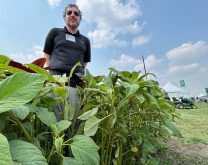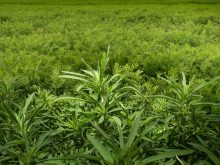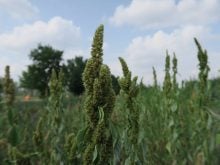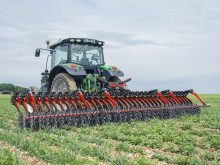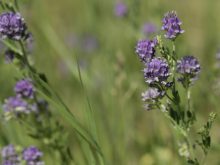A research project near Moose Jaw, Sask., is entering the third and final year of study into how best to control leafy spurge.
The work includes trials of an as-yet unregistered chemical from DuPont, Rejuvra XL, which is showing promise and is expected to be registered for next year.
Moose Jaw River Watershed Stewards and the Moose Jaw Weed Management Area are leading the project 30 kilometres west of the city, where leafy spurge is a dominant plant.
The weed management area, which was formed in 2011, includes four rural municipalities: Caron, Baildon, Moose Jaw and Wheatland.
Read Also

Volatile temperatures expected for this winter
DTN is forecasting a lot of temperature variability in the Canadian Prairies this winter. Precipitation should be close to average.
Bridget Andrews of the watershed said leafy spurge has been a problem in the Caronport and Mortlach areas for more than 50 years.
However, patches have now ap-peared between Regina and Pense and even east of Regina, she said during a recent webinar.
“It is on the move.”
Chemical control in the region is limited by the presence of Thunder Creek and the Moose Jaw River.
A rail line also runs through the watershed, and although the railway does spray, Andrews said there is concern about the strip of land between the line and a landowner’s right-of-way.
The research project is located on a five-acre plot that is covered in leafy spurge and that has never received chemical control.
Fifteen treatments were used, including two control sites.
Treatments used in the first year included:
- three applications of Tordon 22K — 3.6 litres per acre in a June application, 1.89 litres per acre each in June and September and 1.89 litres per acre in September
- three applications of Grazon — 2.8 litres per acre in June, 2.8 litres per acre in September and 2.8 litres per acre in fall with 2,4-D Amine at 370 grams per litre the following spring
- one application of Dicamba at 1.89 litres per acre in June
- one application of Dicamba plus 2,4-D at 1.89 litres per acre and 370 grams per acre, respectively, in September
- one wick treatment of glyphosate in early July
- two treatments of 2,4-D Amine at 370 grams per acre — one in June and one in June and September
- one treatment of Rejuvra XL
- one mowing completed in June
Andrews said the treatments using Tordon, Grazon and Rejuvra were not repeated in the second year to see what long-term control they provided.
BASF requested the addition of two treatments of Overdrive. One used 115 grams per acre of Overdrive with the adjuvent Merge and Tordon 22K at one litre per acre and the other used 230 grams per acre of Overdrive with Merge and Tordon 22K at .5 litre per acre.
Complete results of the second year of the trials are to be released soon, but Andrews said, “I can tell you, it killed things.”
She said the first year showed good results from the treatments that weren’t repeated a second time.
She also said the Tordon 22K and Grazon results were exceptional. The Tordon application saw less than one percent regrowth in every treatment, while there was four percent regrowth with the Grazon treatment after the first year.
The Rejuvra treatment was also impressive, Andrews said.
“We didn’t see any regrowth on it and it looked really good last fall.”
Other treatments didn’t work as well.
The Dicamba spring application, the 2,4-D spring application and the 2,4-D spring and fall applications were disappointing. There was almost 100 percent regrowth.
“We did see it suppress the plant so it didn’t necessarily go to seed,” she said. “However, they’re all back, and of course it’s something that you have to do every year.”
The Dicamba spring application with the fall 2,4-D application saw 23 percent regrowth.
“We were surprised. We expected to see more spurge regrowth. It actually worked quite well.”
Glyphosate wick application did not control the spurge at all, while mowing only suppressed flowering. Andrews said RMs that mow must do so before leafy spurge goes to seed or else they are just spreading the problem.
Preliminary results of last year’s Overdrive treatments showed good control after spraying, but Andrews said the spring plant counts will determine how well it really worked.
John Hauer, a regional forage specialist in Kindersley, Sask., said leafy spurge seeds remain viable in the soil for up to eight years but usually germinate within two.
“Each flowering stem can produce 140 seeds per year,” he said.
As well, the seeds can shoot four metres from the parent plant.
The acreage infested with leafy spurge has doubled every 10 years since the early 1900s, he said.
Hauer said it’s important to gain control because leafy spurge reduces carrying capacity and costs ranchers money.
For example, more than one million acres is infested in North Dakota, which has reduced grazing by 77,000 cows and resulted in lost income to producers of $9 million.
Biological control is an option.
Hauer said 17 beetle species have been released in Saskatchewan. Eleven of those have established populations and two have survived the best.
The black dog spurge beetle prefers hot dry sites, sandy soil and drier knolls, while the brown dot spurge beetle likes moister sites, loamy soil and lower valley areas.
Beetles released in the early 1990s reduced leafy spurge cover to 10 percent from 50 to 70 percent, Hauer said.
Sheep and goat grazing can also reduce the stands.
Andrews said the weed management area has released beetles but hasn’t yet had success in establishing populations.





